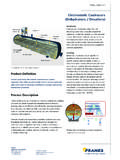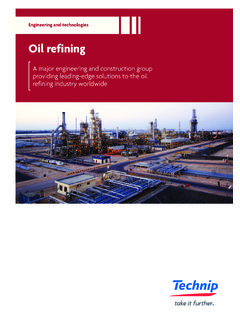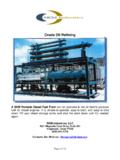Transcription of Crude Oil Treatment - processgroupintl.com
1 AustraliaProcess Group Pty Ltd5 Hobbs Court, Rowville, (Melbourne), VIC 3178, : +61 3 9212 7100 Fax: +61 3 9212 7199E-mail: Web: Process Group Pte Ltd298 Tiong Bahru Road #12-02/03 Central Plaza, Singapore 168730 Phone: +65 6276 8349 Fax: +65 6274 2005E-mail: Web: EastProcess Group International Box 46153, Abu Dhabi, : +971 2 5500 899 Fax: +971 2 5500898E-mail: Web: Oil Treatment Electrostatic & Mechanical Treaters Introduction After primary oil/water separation, there is often a small amount of unwanted salts in residual water in the Crude oil that needs to be reduced to a concentration around 5-10 PTB (Pounds per Thousand Barrels) salt.
2 This salt needs to be removed so that the Crude oil can be processed in a refinery or stabilizer plant without fouling heaters and exchangers and other equipment. Crude Oil Desalting technology is utilised to remove residual salt to meet these type and size of the Desalter that is used is dependent on a number of fundamental factors such as pressure, temperature, fluid viscosity and flow-rate, as well as customer requirements relating to maximum salt allowed in the product oil Group has developed a range of Crude oil dewatering and desalting technologies to be applied in appropriate situations. Description Process Group offers a range of technology options to cover most typical processing requirements related to Crude Oil Desalting: Free Water Knock Outs Effective bulk water removal using horizontal vessels & mechanical coalescing packs to reduce water levels down to 2 - 5% BS&W (Basic Sediment & Water).
3 Heater Treaters Dehydration at elevated temperature using gas or oil fired burners and mechanical (to BS&W) or electrical (to BS&W) coalescing. Dehydrators Dehydration and associated salt removal using high voltage electrical grids to achieve BS&W. Electrostatic Desalters Dilution water used to reduce salt content to 5-10 CoalescersProcess Group s liquid/liquid coalescing media is used in our Free Water Knock Out vessels and Heater Treaters as an economic and reliable way to dehydrate the oil to pipeline specification. Generally the self-cleaning type media is specified as this requires lower : Crude Oil Degasser / Middle: Installation of a Crude Desalter Unit at site / Bottom: Operating Oil Treatment facility designed, built, installed & commissioned by Process GroupRev 04/2014 Represented by: Crude Oil Oil HeatingTo dehydrate most Crude oils (< ~35 API) to water levels where they are acceptable to refineries, heating is needed.
4 This has several benefits: The oil density is reduced relative to the water density, providing better gravity separation, The viscosity is reduced which reduces the flow resistance of water droplets falling through the oil layer, providing better gravity separation, Heat improves coalescing and assists in breaking emulsions that would otherwise prevent separation to the required is generally via a submerged fire-tube either in a separate or combined Dehydration The basic principle behind electrostatic dehydration is that an electrical field is used to excite droplets of brine within the bulk oil phase so that they collide with other droplets and coalesce into larger globules that separate under Electrostatic Coalescers employ two horizontal grids connected to a high voltage AC supply, and the emulsion flows upwards through the grids.
5 The water coalesces and flows downwards, whilst the clean oil leaves via the top of the are used to ensure even plug flow up the vessel and 2 grid system is still widely used, however more modern and improved Low Salt Treaters are available in various other proven styles 3 grids and 1, 2 or 3 phase power supplies, to achieve oil purity of BS&W or important than water content to a refiner is the salt content of the oil. Depending on the downstream process, a limit of between 1- 10 PTB of salt is usually specified which can require additional Treatment beyond dehydration. This can be performed by a Desalter dilution or wash water is injected into the Crude oil feed to the Desalter through a mixing device to dilute the brine to a level where the target salt content can be achieved by the downstream Dehydration difficult applications this wash water can be recovered and recycled in a 2 stage dehydration and desalting process.
6 DegassingTo ensure optimum performance the Crude oil should be stabilised prior to the Electrostatic Treater. This can be done in the Electrostatic Treater, or in a separate vessel located Treaters Process Group also offers Mechanical Treaters with the following benefits and features: Effective design means minimal chemical Treatment Sample points & emulsion drains fitted as standard Adjustable for load & voltage giving maximum flexibility Low maintenance ideal for unmanned plants or facilities Excellent turn-down / turn-up performance Safe electrical design means no overloading; fewer trips Process Group Pty Ltd, 2008 Model of an Electrostatic Coalescer









